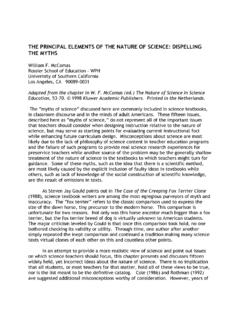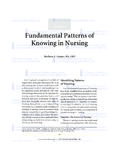Transcription of Summary of Five Perspectives on 'Good Teaching' Each of ...
1 11-12-02 12:00 AMTPI - Teaching Perspectives SummariesPage 1 of 8 Pratt and John CollinsSummary of FivePerspectiveson 'Good Teaching' PrintCloseEach of the paragraphs belowrepresents a different perspective on 'Good teaching'.Together, they will help you understand and interpret yourprofile. Keep in mind that these five are not mutuallyexclusive Perspectives . In our research involving hundredsof teachers, the vast majority hold one or two dominantperspectives. Many hold an additional 'back-up' perspectivethat is high, although not dominant. This combination ofdominant and back-up Perspectives allows teachers toaccommodate changes in context, content, and sense requires that no one can operate from allfive simultaneously, since they represent contrasting andsometimes competing views of teaching. On your profilesheet you also have sub-scores for Beliefs (B), Intention (I),and Actions (A) within each perspective .
2 These sub-scoresscores will further help to identify your philosophy ofteaching by highlighting whether your views within aperspective are grounded (differentially or equally) in whatyou believe, what you intend to accomplish, or whateducational actions you undertake in your teaching teachingrequires a substantialcommitment to the11-12-02 12:00 AMTPI - Teaching Perspectives SummariesPage 2 of 8 or teaching means havingmastery of the subject matter orcontent. Teachers' primaryresponsibilities are to representthe content accurately andefficiently. Learner'sresponsibilities are to learn thatcontent in its authorized orlegitimate forms. Good teacherstake learners systematicallythrough tasks leading to contentmastery: providing clearobjectives, adjusting the pace oflecturing, making efficient use ofclass time, clarifyingmisunderstandings, answeringquestions, providing timelyfeedback, correcting errors,providing reviews, summarizingwhat has been presented, directingstudents to appropriate resources,setting high standards forachievement and developingobjective means of assessinglearning.
3 Good teachers areenthusiastic about their contentand convey that enthusiasm totheir students. For many learners,good transmission teachers arememorable presenters of 12:00 AMTPI - Teaching Perspectives SummariesPage 3 of 8 teaching is aprocess of socializingstudents into newbehavioral norms andways of teachers are highly skilledpractitioners of what they in classrooms or at worksites, they are recognized for theirexpertise. Teachers must revealthe inner workings of skilledperformance and must translate itinto accessible language and anordered set of tasks which usuallyproceed from simple to complex,allowing for different points ofentry depending upon the learner'scapability. Good teachers knowwhat their learners can do on theirown and where they needguidance and direction; theyengage learners within their 'zoneof development'. As learnersmature and become morecompetent, the teacher 's rolechanges; they offer less directionand give more responsibility asstudents progress from dependentlearners to independent teaching11-12-02 12:00 AMTPI - Teaching Perspectives SummariesPage 4 of 8 be planned andconducted "from thelearner's point ofview".
4 Good teachers must understandhow their learners think andreason about the content. Theprimary goal is to help learnersdevelop increasingly complex andsophisticated cognitive structuresfor comprehending the key to changing thosestructures lies in a combination oftwo skills: (1) effective questioningthat challenges learners to movefrom relatively simple to morecomplex forms of thinking, and (2)'bridging knowledge' whichprovides examples that aremeaningful to the , problems, cases, andexamples form these bridges thatteachers use to transport learnersfrom simpler ways of thinking andreasoning to new, more complexand sophisticated forms ofreasoning. Good teachers adapttheir knowledge to learners' levelsof understanding and ways teaching11-12-02 12:00 AMTPI - Teaching Perspectives SummariesPage 5 of 8 that long-term, hard, persistenteffort to achievecomes from the heart,not the become motivated andproductive learners when they areworking on issues or problemswithout fear of failure.
5 Learnersare nurtured in knowing that (a)they can succeed at learning ifthey give it a good try; (b) theirachievement is a product of theirown effort and ability, rather thanthe benevolence of a teacher ; and(c) their learning efforts will besupported by both teacher andpeers. Good teachers care abouttheir students and understand thatsome have histories of failureresulting in lowered self-confidence. However they make noexcuses for learners. Rather, theyencourage their efforts whilechallenging students to do theirvery best by promoting a climateof caring and trust, helping peopleset challenging but achievablegoals, and supporting effort as wellas achievement. Good teachersprovide encouragement andsupport, along with clear11-12-02 12:00 AMTPI - Teaching Perspectives SummariesPage 6 of 8 and reasonable goalsfor all learners but do not sacrificeself-efficacy or self-esteem forachievement. Their assessments oflearning consider individual growthas well as absolute ReformEffective teachingseeks to changesociety in the Social Reform point ofview, the object of teaching is thecollective rather than theindividual.
6 Good teachers awakenstudents to values and ideologiesthat are embedded in texts andcommon practices within theirdisciplines. Good teacherschallenge the status quo andencourage students to considerhow learners are positioned andconstructed in particular discoursesand practices. To do so, theyanalyze and deconstruct commonpractices for ways in which suchpractices perpetuate conditionsthat are unacceptable. Classdiscussion is focused less on howknowledge has been created, andmore by whom and for whatpurposes. Texts are interrogated11-12-02 12:00 AMTPI - Teaching Perspectives SummariesPage 7 of 8 what is said and what is notsaid; what is included and what isexcluded; who is represented andwho is omitted from the dominantdiscourse. Students areencouraged to take critical stancesto give them power to take socialaction to improve their own livesand the lives of others. Criticaldeconstruction, though central tothis view, is not an end in Simple Steps For Interpreting Your TPI Profile1.
7 Review the Summary Paragraphs: Remind yourself what philosophical viewpoint each of the fiveperspectives represents: Transmission, Apprenticeship, Developmental, Nurturing, and Social Reform. Remember, these are Teaching Perspectives ; not personality-based styles or technical methods . 2. Examine Your Profile Sheet: The height of each of the five vertical bars on your profile representshow strongly you hold each of the five Perspectives outlined on the Summary Sheet: Transmission,Apprenticeship, Developmental, Nurturing, and Social Reform. Remember that all teachers embody allfive views, but in varying degrees. (Note: Depending on the version you re using, the order of theparagraphs may not be quite the same as the bars on your profile sheet. Not to worry!) 3. Note the Height and Range of Your Overall Scores: Scores on the profile sheet can range from aminimum of 9 to a maximum of 45. Do your scores overall generally fall in the 40s?
8 Or the 30s? Or 20s? Are your individual Perspectives strongly held? Moderately held? Weakly held? Do you know anyonewho holds stronger views on teaching? What might this suggest? 4. Check the Differentiation among Your Perspectives : On which perspective is your score thehighest? Lowest? Are there marked (step-like) differences among your scores, some high and otherslow? Or is your profile somewhat flat , with smaller differences between your highs and lows? Keep inmind that to agree with some items meant that you must logically disagree with others--you cannot agreewith everything. As you were completing the TPI, did you keep a single, specific educational context inmind? 5. Identify Your Dominant, Back-Up, and Recessive Perspectives : Do one or two of your perspectivescores fall at or above the upper line labeled Dominant ? Which one? Most people have at least one(occasionally two) dominant Perspectives that represent strongly held views on their roles and functionsas educators.
9 Similarly, most people have one or two Back-up Perspectives that are also high, but11-12-02 12:00 AMTPI - Teaching Perspectives SummariesPage 8 of 8 less so than their dominant perspective . Which are your Back-Up Perspectives ? Do any ofyour scores fall at or below the lower line labeled Recessive ? Which one? These dominant andrecessive thresholds are keyed to your profile individually (+/- 1 SD around the mean of your own fivescores). They are not influenced by how other people score on their profiles. For you, which areDominant? Back-up? Recessive?6. Check for Internal Consistency: Examine the sub-scores labeled B, I, and A (near the top of eachbar). Your score on each of your five Perspectives is comprised of three sub-scores: a Belief sub-score,an Intention sub-score, and an Action sub-score. These sub-scores are indicators of how muchagreement exists between what you do (Actions), what you want to accomplish (Intentions), and why youfeel that is important or justified (Beliefs).
10 High internal consistency (sub-scores within one or two pointsof each other) means that your Beliefs, Intentions, and Actions all corroborate each other. 7. Examine any Internal Discrepancies: If your B, I, A sub-scores differ by three or more points,inconsistencies may exist that you should consider. Where your sub-scores differ by 3, 4, 5 or morepoints, look to see where the differences occur. Within which perspective ? Between which sub-scores:Beliefs and Actions? Between Intentions and Actions? Between Actions and Intentions? What mightexplain these differences? Job constraints? Philosophical inconsistencies? Non-clarity aboutdepartmental expectations? 8. Look for Consistency Across Perspectives : Examine the Intentions sub-score for all fiveperspectives. Does the highest Intention sub-score occur within your dominant perspective ? If not, wheredoes it occur and what might that indicate?









